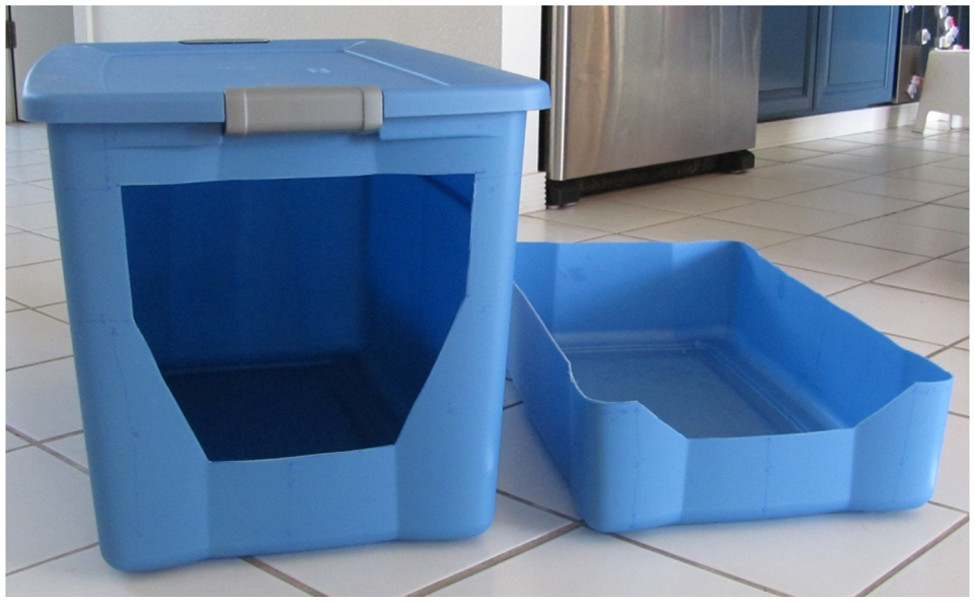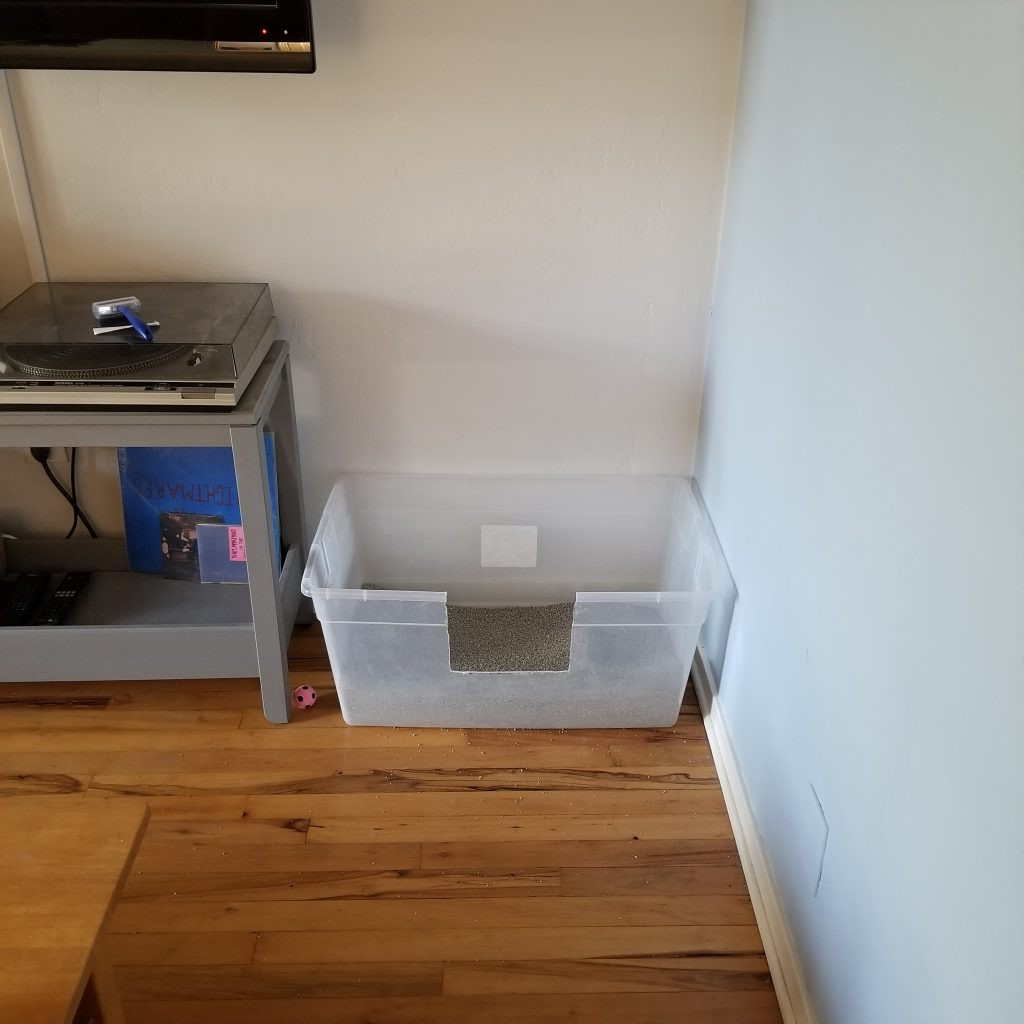As a cat behavior consultant, I’m always diving into the latest research to ensure I’m giving the best advice to cat owners. Recently, while catching up on continuing education, a presentation touched on a common belief about cat litter boxes – specifically, covered versus uncovered options. The presenter mentioned a 2013 study suggesting cats don’t actually dislike hooded litter boxes, challenging the long-held view in the cat behavior community. This sparked my interest and prompted me to revisit this study and delve deeper into the topic of Covered Cat Litter Boxes.
For many years, cat behavior experts, including myself, have generally advised against covered litter boxes. We’ve had solid reasons for this stance, which I’ll elaborate on. However, this reference to a 2013 study by Dr. Emma Grigg offered a valuable opportunity to re-examine the science and understand the nuances. It also highlighted the importance of critically reviewing scientific papers and considering research findings within a broader context.
This article will explore the findings of that 2013 study on cat litter box preference and discuss why a single study shouldn’t be the only factor influencing your choice of litter box – especially when it comes to covered models.
Understanding the 2013 Litter Box Study
The study, titled “Litter box preference in domestic cats: covered versus uncovered,” aimed to investigate whether cats truly prefer uncovered litter boxes. Researchers observed 27 healthy indoor cats, all with no prior history of litter box issues. For two weeks, each cat was provided with two litter box options:
- Covered Litter Box: A large storage bin with a lid and an entryway cut into it.
- Uncovered Litter Box: An identical storage bin with sides cut down to about 6 inches high and a lower entryway.
Both boxes were placed side-by-side and contained the same type of clay, clumping litter. Cats from multi-cat households were temporarily separated to ensure individual data collection. Owners were instructed to scoop waste daily, and researchers meticulously weighed the waste from each box to determine preference.
 Two litter boxes, one covered and one uncovered, used in the 2013 study on cat litter box preference.
Two litter boxes, one covered and one uncovered, used in the 2013 study on cat litter box preference.
Key Findings of the Study
The results indicated that, as a group, the cats did not show a statistically significant preference for either covered or uncovered litter boxes. The amount of waste deposited in each type of box was roughly the same across the entire group. When looking at individual cat behavior, 19 out of the 27 cats used both types of litter boxes equally.
Based solely on these results, one might conclude that covered litter boxes are perfectly acceptable for most cats. However, before making such a definitive statement and rushing to buy a covered box, it’s crucial to consider several important caveats highlighted by the study itself and broader cat behavior knowledge.
Caveats to Consider Before Choosing Covered Cat Litter Boxes
While the 2013 study provides valuable data, it’s essential to understand its limitations and context. Here are key caveats that cat owners should consider regarding covered cat litter boxes:
1. Individual Cat Preferences Still Matter
Even though the overall study population didn’t show a strong preference, the research revealed that individual preferences do exist. Eight out of the 27 cats demonstrated a clear preference: four favored covered boxes, and four preferred uncovered ones.
 A cat owner observing their cat interacting with an uncovered litter box, highlighting individual preferences in litter box choice.
A cat owner observing their cat interacting with an uncovered litter box, highlighting individual preferences in litter box choice.
This underscores a critical point: scientific studies often analyze populations, but individual cats have unique needs and preferences. What works for the “average” cat may not work for your cat. The best way to determine your cat’s preference is to offer choices and observe their behavior.
2. The Size Factor: Study Boxes vs. Commercial Covered Litter Boxes
A significant detail often overlooked is the size of the litter boxes used in the study. Researchers used large storage bins, measuring approximately 32.5 inches long, 19.75 inches wide, and 19 inches high. These are significantly larger than most commercially available covered litter boxes marketed to cat owners.
Many “large” covered litter boxes on the market are closer to 19.5 x 15.25 x 17 inches – roughly half the size of the boxes used in the study. The spaciousness of the study boxes might have been a key factor in why cats didn’t express a strong aversion to the covered option. Cats might react differently to smaller, more confined covered boxes commonly found in pet stores. Supporting this idea, a 2014 study indicates that cats generally prefer larger litter boxes.
Notably, the 2013 study also hinted that larger cats (over 13 lbs) showed a trend towards preferring uncovered boxes, further suggesting size is a factor in preference.
3. The Impact of Multi-Cat Households
The study intentionally separated cats from their housemates. In reality, many cat owners have multi-cat households, where social dynamics significantly influence litter box behavior. One primary reason cat behaviorists often advise against covered litter boxes is that they can limit a cat’s visibility and escape routes, potentially causing stress, especially in multi-cat homes.
A covered box can create a feeling of being trapped or ambushed by other cats. An uncovered box allows a cat to see their surroundings and have multiple escape routes, promoting a sense of security and reducing anxiety around litter box use. In a multi-cat setting, this visibility can be crucial for comfortable and consistent litter box habits.
4. Cleaning Frequency: Out of Sight, Out of Mind?
Participants in the 2013 study were diligent about scooping litter boxes daily. This frequent cleaning likely contributed to the appeal of both box types. However, real-world scenarios often differ. Research suggests that covered litter boxes are often cleaned less frequently – sometimes as infrequently as once every five days. The “out of sight, out of mind” aspect of covered boxes might lead to less consistent cleaning.
A more recent study of cat owners in Italy linked infrequent litter box scooping to house-soiling issues. Daily scooping, or even twice-daily scooping, is crucial for maintaining a litter box environment that is appealing to cats, and covered boxes may inadvertently hinder this practice.
Key Takeaways: Making Informed Choices About Covered Litter Boxes
The 2013 study provides valuable insights: when cats are given large litter boxes with clumping litter that is scooped daily, population-level preference for covered vs. uncovered boxes is not significant. However, this doesn’t mean covered litter boxes are universally ideal.
Here are crucial takeaways for cat owners:
- Individual preference is paramount: Pay attention to your cat’s behavior and preferences. Offer choices if possible.
- Size matters: If you opt for a covered box, ensure it’s generously sized – much larger than typical commercial options if possible.
- Consider your household: In multi-cat homes, uncovered boxes are generally a safer choice to reduce social stress.
- Cleaning is non-negotiable: Regardless of box type, frequent scooping is essential. Covered boxes should not be an excuse for less frequent cleaning.
In most typical home environments, especially with commercially available covered litter boxes and varying cleaning habits, the conditions of the 2013 study are unlikely to be replicated. Therefore, while the study is informative, it’s wise to remain cautious about recommending covered litter boxes as a default choice.
Expert Tips for Excellent Litter Box Setup
Instead of focusing on covered vs. uncovered, prioritize creating a litter box environment that meets your cat’s fundamental needs. Here are ten quick tips for excellent litter box management, regardless of the box style:
- Number of Boxes: Have at least as many litter boxes as you have cats, plus one.
- Size: Use large, open litter boxes.
- Easy Entry: Ensure the box is easy for your cat to enter and exit.
- Litter Type: Use unscented, soft, clumping-style clay litter.
- Avoid Liners: Skip plastic litter liners.
- Scoop Frequently: Scoop litter boxes at least once, ideally twice, daily.
- Location, Location, Location: Place litter boxes in quiet, accessible locations that offer a vantage point.
- Separate Locations: Place each litter box in a different location, if possible.
- Distance from Resources: Keep litter boxes away from eating, drinking, and sleeping areas.
- Avoid Problematic Boxes: Avoid robot/automatic litter boxes and top-entry litter boxes, which can be stressful or difficult for cats.
 A large, open storage bin used as a litter box, demonstrating an ideal size and type for cat comfort and hygiene.
A large, open storage bin used as a litter box, demonstrating an ideal size and type for cat comfort and hygiene.
By focusing on these essential elements, you can create a litter box setup that encourages good habits and minimizes the risk of litter box problems, ultimately contributing to your cat’s well-being and a harmonious home.
References
Grigg, E. K., Pick, L., & Nibblett, B. (2013). Litter box preference in domestic cats: covered versus uncovered. Journal of Feline Medicine and Surgery, 15(4), 280-284.
Guy, N. C., Hopson, M., & Vanderstichel, R. (2014). Litterbox size preference in domestic cats (Felis catus). Journal of Veterinary Behavior, 9(2), 78-82.
Horwitz, D. F. (1997). Behavioral and environmental factors associated with elimination behavior problems in cats: a retrospective study. Applied Animal Behaviour Science, 52(1-2), 129-137.
Padalino, B., Zappaterra, M., Felici, M., Ricci-Bonot, C., Nanni Costa, L., Houpt, K., & Tateo, A. (2023). Factors associated with house-soiling in Italian cats. Journal of Feline Medicine and Surgery, 25(11), 1098612X231202482.

